|
Author
|
Topic: Coke and Pepsi aboard the space shuttle
|
NavySpaceFan
Member Posts: 660
From: Norfolk, VA
Registered: May 2007
|
 posted 07-18-2008 11:53 AM
posted 07-18-2008 11:53 AM
   
I was at the Astronaut Hall of Fame and I saw in the shuttle exhibit a Coke dispenser flown on board Endeavour during STS-77. Does anyone know anything about this? I thought that the only sodas flown were during STS-51F back in 1985. |
Robert Pearlman
Editor Posts: 44454
From: Houston, TX
Registered: Nov 1999
|
 posted 07-18-2008 12:57 PM
posted 07-18-2008 12:57 PM
   
The "Coca-Cola Space Dispenser" (Fluids Generic Bioprocessing Apparatus) was designed to provide astronauts the opportunity to enjoy Coca-Cola and Diet Coke in the weightless environment of space. It held 1.65 liters each of Coca-Cola and Diet Coke.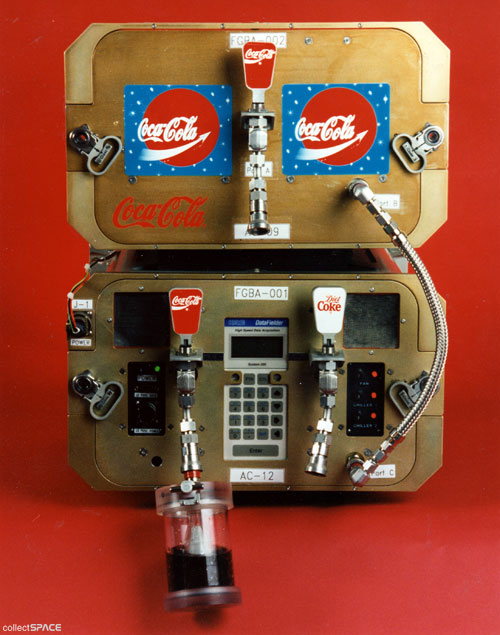 An astronaut would dispense the carbonated drink of choice into a "Fluids Transfer Unit" or sealed drinking cup through a quick connect on the dispenser. Made from clear polycarbonate, the FTU was based on the design of the Coca-Cola Space Can first flown in 1985 and held up to seven ounces. The design incorporated a unique baffle and thin vanes at its bottom to keep the liquid and carbon dioxide (CO2) from separating. Eighteen (18) of the "space cups" and the dispenser first flew on shuttle Discovery's STS-63 mission in 1995. 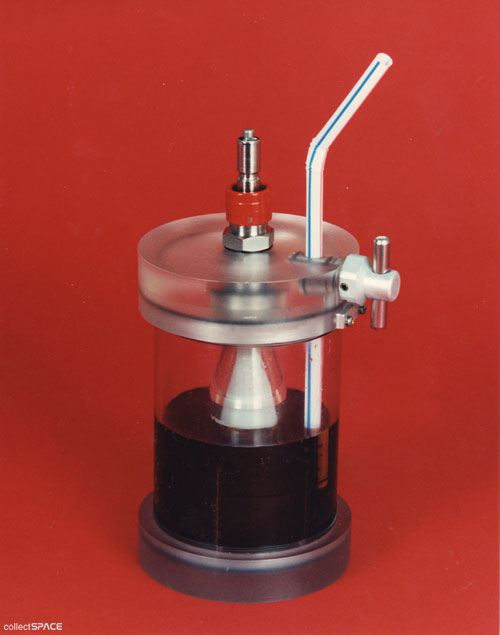 Fluids Generic Bioprocessing Apparatus-1 (FGBA-1)The Fluids Generic Processing Apparatus-1 is the first of three commercial payloads being developed by BioServe Space Technologies. BioServe is a NASA Center for the Commercial Development of Space (CCDS) located at the University of Colorado, Boulder. A consortium of private businesses, universities and government, including The Coca-Cola Company, Atlanta, GA; Martin Marietta, Denver, CO; Ohmeda, Boulder, CO; University of Colorado, Boulder; Kansas State University, Manhattan, KS; and NASA's Office of Space Access and Technology, Washington, DC, have combined resources to sponsor the FGBA commercial program. The consortium has a major long-range objective in advancing fluid management technology in microgravity. Consistent with this objective, this first BioServe FGBA experiment represents a significant opportunity to obtain fundamental data on containment, manipulation and transfer of pressurized, supersaturated two-phase fluids. During STS-63, this program is expected to further the commercial objectives of The Coca-Cola Company in developing both terrestrial and space applications. The Coca-Cola Company has a strong interest in developing hardware to carbonate water on demand and to mix and dispense beverages with minimal loss of carbonation. Developing technology to accomplish these objectives in microgravity may likely evolve into terrestrial applications that could further the long-range research and development objectives of The Coca-Cola Company. This flight will provide baseline data on changes in astronauts' taste perception of beverages consumed in microgravity. The beverages to be used in the evaluation are Coca-Cola and diet Coke. The taste perception changes experienced by astronauts on-orbit will be compared to their taste perception of these beverages in matched pre- and post-flight ground controls involving the same crew members. Dr. George Morgenthaler, Director of the BioServe CCDS, is Program Manager for the FGBA experiment. Drs. Louis Stodieck and Alex Hoehn, also of BioServe, are responsible for mission management. Dr. Ashis Gupta is the principal engineer for this experiment for The Coca-Cola Company. An upgraded version of the device flew on STS-77 as the Fluids Generic Bioprocessing Apparatus-2 (FGBA-2). Rather than just storing the beverages as earlier versions did, the dispenser tested if carbonated beverages could be produced from separately stored carbon dioxide, water and flavored syrups and if the resulting fluids could be made available for consumption without foam formation. Unfortunately, the FGBA-2 did not work as expected.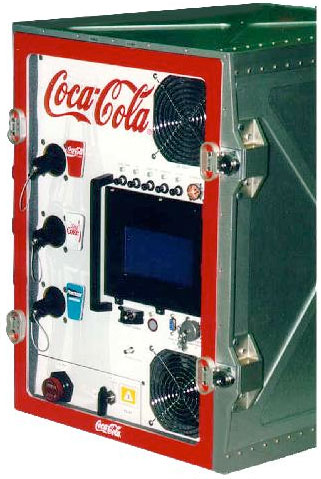 FGBA-2 Unlike Pepsi's efforts in space, which were primarily for promotion, Coca-Cola made a serious investment into their research. In addition to a desire to offer carbonated beverages for astronauts, Coca-Cola was also observing the effects of space flight on changes in taste perception with the goal of understanding altered tastes in specific target populations on Earth, such as the elderly. In regards to what is on display at the Astronaut Hall of Fame, as you can see from the photos that the FGBA and the FGBA-2 differed greatly in appearance. If indeed the device at the Hall of Fame is described as flown on STS-77, then I believe it is in error. It appears that what they have is FGBA-002, the second unit (by serial number) of what was prepared for STS-63, rather than the FGBA-2 flown on STS-77. |
Robert Pearlman
Editor Posts: 44454
From: Houston, TX
Registered: Nov 1999
|
 posted 07-18-2008 01:59 PM
posted 07-18-2008 01:59 PM
   
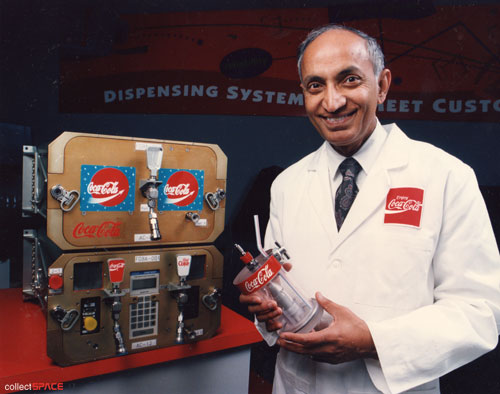 Coca-Cola scientist Dr. Ashis Gupta 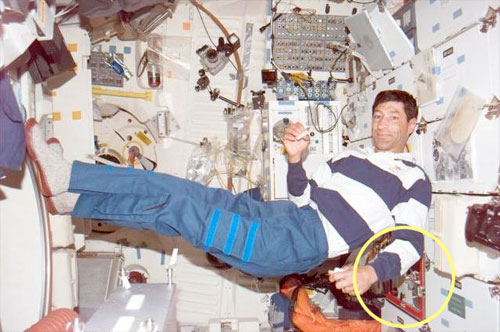
Mario Runco floats near the FGBA-2 on STS-77. |
NavySpaceFan
Member Posts: 660
From: Norfolk, VA
Registered: May 2007
|
 posted 07-18-2008 08:09 PM
posted 07-18-2008 08:09 PM
   
The unit on display is the first iteration, and it's credited by the Astronaut Hall of Fame with flying on STS-77. So they goofed. Thanks for the background! |
Philip
Member Posts: 6056
From: Brussels, Belgium
Registered: Jan 2001
|
 posted 07-27-2008 04:44 AM
posted 07-27-2008 04:44 AM
   
Don't forget Pepsi in space: Both on MIR (with some publicity during an EVA) and on the early shuttle flights! |
Robert Pearlman
Editor Posts: 44454
From: Houston, TX
Registered: Nov 1999
|
 posted 07-27-2008 05:10 AM
posted 07-27-2008 05:10 AM
   
I don't believe Pepsi, the actual beverage, ever made it to Mir. They did fly an inflatable over-sized bottle to shoot a commercial, but the only time Pepsi flew its soda was on STS-51F, and that was in response to Coca-Cola's payload flying for the first time on that same mission. |
Jay Chladek
Member Posts: 2272
From: Bellevue, NE, USA
Registered: Aug 2007
|
 posted 07-31-2008 02:08 AM
posted 07-31-2008 02:08 AM
   
I've always wondered about why the soft drink companies did research into this. The biggest problem with carbonated beverages consumed in Earth orbit as I see it is an astronaut can't necessarily burp out the excess CO2 since to my knowledge, the gas bubbles just sit in the stomach due to microgravity.Air bubbles were a problem on a couple of the shuttle flights when too much air was added to some of the astronauts' drinks and it can result in some gas pain discomfort. I recall it happened on one of Tom Jones' flights (as documented in his book "Sky Walking") and until a fix was developed, one of the other crewmembers came up with a technique to spin his drink bags so the gas would "rise" to the top while the fluid would go to the bottom. Now if we ever get back to the Moon or land on Mars (or come up with an artificial gravity environment, ala Space Station 5 in 2001), then I can see such drinks potentially becoming popular tastes of home. Granted I suppose that Coke might have also done some research into using less CO2 in their drinks for space while still trying to maintain the same tingling flavor on the taste buds. I suppose if a better refrigeration system were utilized (stick it in the freezer on the ISS!) then I could also see a use for Coke flavored ice pops of some sort. They wouldn't be carbonated, but would be cold and tastey I imagine, sort of like a Coke float in space. Now from a collectability standpoint, about ten years ago I did find a plastic Coca Cola drink container which was shaped like the one that flew on STS-51F at a second chance store. This was a premium that Space Camp came out with at the time of the flight and it only looked like the real dispenser as opposed to being a true replica of it. I presented it to Bill Grush from Star Realm as a gift for his collection rather then keeping it for myself, since I knew he would potentially take care of it better then I could. |
denali414
Member Posts: 691
From: Raleigh, NC
Registered: Aug 2017
|
 posted 08-09-2020 06:16 PM
posted 08-09-2020 06:16 PM
   
Just acquired one of the Pepsi commemorative space shuttle cans and was just curious how many Pepsi made? Was it a large quantity? Do not see very often.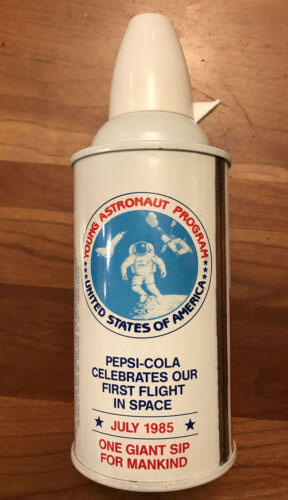 |
Robert Pearlman
Editor Posts: 44454
From: Houston, TX
Registered: Nov 1999
|
 posted 08-11-2020 12:15 AM
posted 08-11-2020 12:15 AM
   
collectSPACE 'Space cola wars' at 35: When Coca-Cola, Pepsi tested soda in spaceJohn-David Bartoe was having none of it. A payload specialist aboard a 1985 flight of the space shuttle Challenger, Bartoe sequestered himself away from his six crewmates. He was glad to be on his first mission and even happier to have made it safely into space after what was the space shuttle program's first and only abort-to-orbit, but becoming one of the first astronauts to drink Coca-Cola or Pepsi off Earth was a sip too far. "I thought it was frivolous and detracting from the science of the mission. I didn't like it all," said Bartoe, reflecting 35 years later on what the media dubbed then the "space cola wars." "I said, 'I'm not going to do it, I think it it's a terrible idea.'" 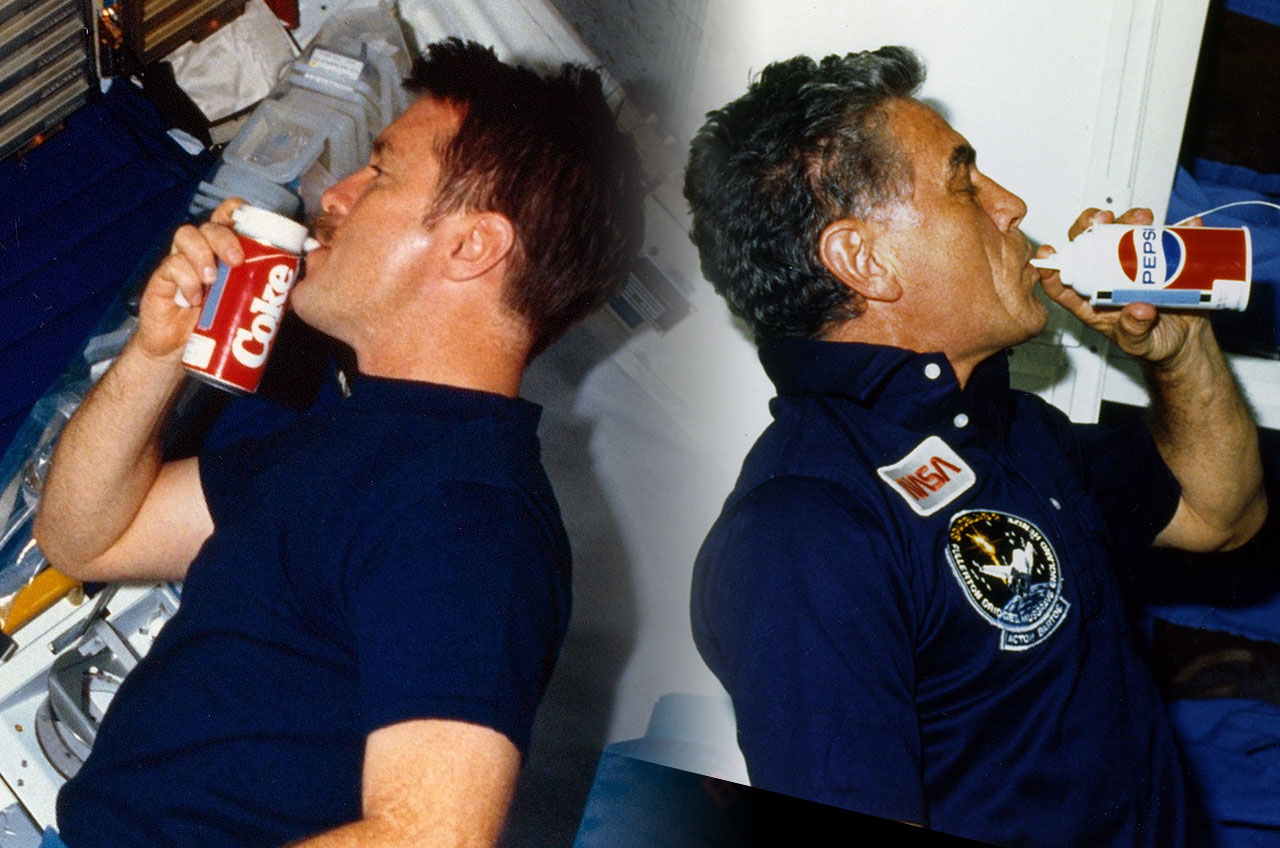 |
Greggy_D
Member Posts: 980
From: Michigan
Registered: Jul 2006
|
 posted 08-11-2020 09:38 AM
posted 08-11-2020 09:38 AM
   
Fantastic article, Robert. I loved the past and present insights from Bartoe. |
Robert Pearlman
Editor Posts: 44454
From: Houston, TX
Registered: Nov 1999
|
 posted 08-11-2020 11:45 AM
posted 08-11-2020 11:45 AM
   
Thanks! There is more about the STS-51F Carbonated Beverage Container Evaluation and the subsequent flights by Coca-Cola that I hope to be able to tell in future articles. |
denali414
Member Posts: 691
From: Raleigh, NC
Registered: Aug 2017
|
 posted 08-11-2020 03:01 PM
posted 08-11-2020 03:01 PM
   
Great article Robert! Thanks for all this background. Still hoping someone knows how many of the Pepsi cans were made. |
MarylandSpace
Member Posts: 1365
From:
Registered: Aug 2002
|
 posted 08-11-2020 04:04 PM
posted 08-11-2020 04:04 PM
   
Nicely written article Robert and the photos enhance the story. |
Pete Sarmiento
Member Posts: 21
From: Fort Washington, MD, USA
Registered: Mar 2006
|
 posted 08-13-2020 10:55 AM
posted 08-13-2020 10:55 AM
   
I try to obtain a Coke can from Coke HQ at Atlanta during the time they were just playing around with it. I think, they only made about five to six of them. I do not know much about Pepsi.Anyway, here are the two famous photos of the two cans. 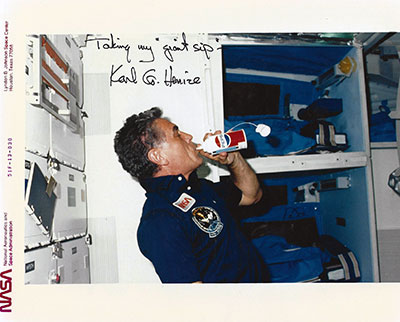 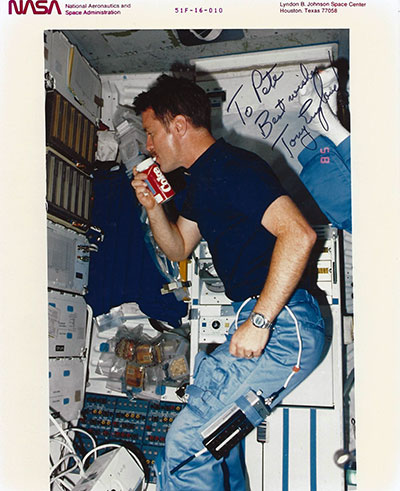
|
Liembo
Member Posts: 659
From: Bothell, WA
Registered: Jan 2013
|
 posted 08-13-2020 11:30 AM
posted 08-13-2020 11:30 AM
   
US Space Camp sold a replica Coca Cola can as a water bottle type receptacle. It approximately matched the design of the original. 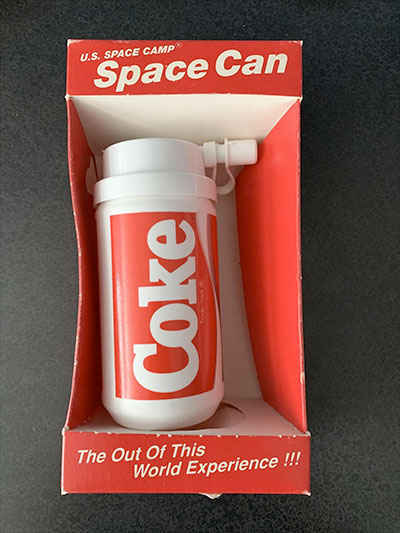 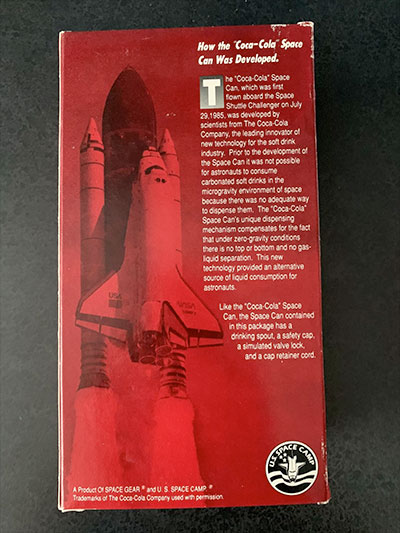
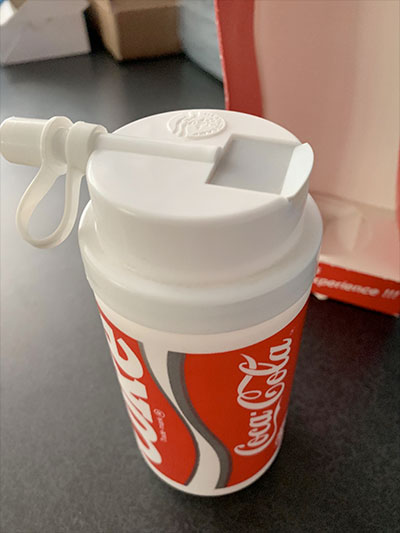
|
goose77
Member Posts: 50
From: Marion, Iowa
Registered: Jul 2019
|
 posted 08-13-2020 11:53 AM
posted 08-13-2020 11:53 AM
   
quote:
Originally posted by denali414:
Still hoping someone knows how many of the Pepsi cans were made.
I also acquired one of the Pepsi cans awhile ago and am also curious about how many were produced and how they were originally distributed. |























